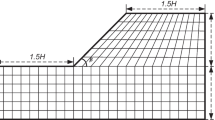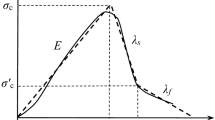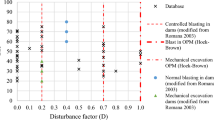Abstract
Excavation of a rock slope will form an excavation disturbance/damage zone (EDZ) near the excavation boundary. This paper proposes an EDZ analysis method based on point safety factor. The ratio of the shear stress to shear strength of each point in the slope is defined as the point safety factor, and the expression of the point safety factor under the Mohr–Coulomb and Hoek–Brown criteria is derived. The point safety factor before and after the excavation of a highway rock slope is calculated, and the influence of the Hoek–Brown parameters on the point safety factor is studied. The change rate of the point safety factor before and after slope excavation is used as a quantitative index to study the scope of EDZ, and the influence of excavation angle on EDZ is discussed. The results show that the point safety factor first increases and then decreases from the slope surface to the slope interior. After the slope is excavated, the point safety factor at the toe of the excavation face is significantly reduced, and its change is related to the stress adjustment of the rock mass in the slope. The point safety factor increases with the increase of the geological strength index GSI and uniaxial compressive strength σci of the rock mass, and decreases with the increase of the material constant mi and the disturbance factor D. As the excavation angle increases, the range of EDZ becomes smaller. The maximum point safety factor change rate occurs on the excavation boundary with a height of 1.8 ~ 2.0 m, which first increases and then decreases with the increase of the excavation angle.










Similar content being viewed by others
References
An HM, Liu HY, Han HY (2020) Hybrid finite-discrete element modelling of excavation damaged zone formation process induced by blasts in a deep tunnel. Adv Civ Eng 2020:1–27
Balmer G (1952) A general analytical solution for Mohr’s envelope. Am Soc Test Mater 52:1269–1271
Bonilla-Sierra V, Scholtes L, Donze FV et al (2015) Rock slope stability analysis using photogrammetric data and DFN-DEM modelling. Acta Geotech 10(4):497–511
Bao H, Wu FQ, Xi PC et al (2020a) A new method for assessing slope unloading zones based on unloading strain. Environ Earth Sci 79(14):1–13
Bao H, Zhang KK, Yan CG et al (2020) Excavation damaged zone division and time-dependency deformation prediction: a case study of excavated rock mass at Xiaowan Hydropower Station. Eng Geol 272:105668
Carranza-Torres C, Diederichs M (2009) Mechanical analysis of circular liners with particular reference to composite supports. For example, liners consisting of shotcrete and steel sets. Tunn Undergr Space 24:506–532
Cen DF, Huang D, Ren F (2017) Shear deformation and strength of the interphase between the soil-rock mixture and the benched bedrock slope surface. Acta Geotech 12(2):391–413
Cho WJ, Kim JS, Lee C et al (2013) Gas permeability in the excavation damaged zone at KURT. Eng Geol 164:222–229
Eberhardt E (2012) The Hoek-Brown Failure Criterion. Rock Mech Rock Eng 45(6):981–988
Gibert D, Nicollin F, Kergosien B et al (2006) Electrical tomography monitoring of the excavation damaged zone of the Gallery 04 in the Mont Terri rock laboratory: Field experiments, modelling, and relationship with structural geology. Appl Clay Sci 33(1):21–34
Hoek E, Brown ET (2019) The Hoek-Brown failure criterion and GSI–2018 edition. J Rock Mech Geotech Eng 11(3):445–463
Hoek E, Caranza-Torres CT, Corcum B (2002) Hoek–Brown failure criterion-2002 edition. In: Bawden HRW, CurranJ, Telsenicki M (eds) Proceedings of the North American Rock Mechanics Society (NARMS-TAC 2002). Mining Innovation and Technology, Toronto, pp 267–273
Hudson JA, Stephansson O, Andersson J et al (2001) Coupled T-H-M issues relating to radioactive waste repository design and performance. Int J Rock Mech Min Sci 38(1):143–161
Jiang YJ, Li B, Yamashita Y (2009) Simulation of cracking near a large underground cavern in a discontinuous rock mass using the expanded distinct element method. Int J Rock Mech Min Sci 46(1):97–106
Kim JS, Kwon S, Cheon DS et al (2014) Assessment of rock slope stability and factor analysis with a consideration of a damaged zone. Tunn Undergr Space 24(3):187–200
Li HB, Liu MC, Xing WB et al (2017) Failure mechanisms and evolution assessment of the excavation damaged zones in a large-scale and deeply buried underground powerhouse. Rock Mech Rock Eng 50(7):1883–1900
Lai XP, Ren FH, Wu YP et al (2009) Comprehensive assessment on dynamic roof instability under fractured rock mass conditions in the excavation disturbed zone. Int J Rock Mech Min Sci 16(1):0–18
Lu WB, Hu YG, Yang JH et al (2013) Spatial distribution of excavation induced damage zone of high rock slope. Int J Rock Mech Min Sci 64(6):181–191
Maineult A, Thomas B, Nussbaum C et al (2013) Anomalies of noble gases and self-potential associated with fractures and fluid dynamics in a horizontal borehole, Mont Terri Underground Rock Laboratory. Eng Geol 156:46–57
Martino JB, Chandler NA (2004) Excavation-induced damage studies at the underground research laboratory. Int J Rock Mech Min Sci 41(8):1413–1426
Priest SD (2005) Determination of shear strength and three-dimensional yield strength for the Hoek-Brown criterion. Rock Mech Rock Eng 38(4):299–327
Rutqvist J, Bögesson L, Chijimatsu M et al (2008a) Modeling of damage, permeability changes and pressure responses during excavation of the TSX tunnel in granitic rock at URL. Canada Environ Geol 57(6):1263–1274
Rutqvist J, Bäckström A, Chijimatsu M et al (2008b) A multiple-code simulation study of the long-term EDZ evolution of geological nuclear waste repositories. Environ Geol 57(6):1313–1324
Sheng Q, Yue ZQ, Lee CF et al (2002) Estimating the excavation disturbed zone in the permanent shiplock slopes of the three gorges project, china. Int J Rock Mech Min Sci 39(2):165–184
Siren T, Kantia P, Rinne M (2015) Considerations and observations of stress-induced and construction-induced excavation damage zone in crystalline rock. Int J Rock Mech Min Sci 73:165–174
Tang B, Cheng H, Tang YZ et al (2018) Excavation damaged zone depths prediction for TBM-excavated roadways in deep collieries. Environ Earth Sci 77(5):165
Wang XQ (2011) Radon anomaly analysis of engineering slopes. Adv Mater Res 261–263:1161–1166
Wu FQ, Liu JY, Liu T et al (2009) A method for assessment of excavation damaged zone (EDZ) of a rock mass and its application to a dam foundation case. Eng Geol 104(3):254–262
Xie LX, Lu WB, Zhang QB et al (2017) Analysis of damage mechanisms and optimization of cut blasting design under high in situ stresses. Tunn Undergr Space 66:19–33
Xu DP, Gu GK, Wan LP et al (2018) An index for estimating the stability of the layered rock masses under excavation disturbance. Avd Mater Sci Eng 2018:1–11
Yang JH, Dai JH, Yao C et al (2020) Estimation of rock mass properties in excavation damage zones of rock slopes based on the Hoek-Brown criterion and acoustic testing. Int J Rock Mech Min Sci 126:104192
Zareifard MR, Fahimifar A (2016) Analytical solutions for the stresses and deformations of deep tunnels in an elastic–brittle–plastic rock mass considering the damaged zone. Tunn Undergr Space 58:186–196
Zhao WH, Frost JD, Huang RQ et al (2017) Distribution and quantitative zonation of unloading cracks at a proposed large hydropower station dam Site. J Mt Sci 14(10):2106–2121
Zheng HH, Li TB, Shen JY et al (2018) The effects of blast damage zone thickness on rock slope stability. Eng Geol 246:19–27
Acknowledgements
This study was partially supported by the National Natural Science Foundation of China (51809151, U1965109), Open Research Foundation of Guangxi Geomechanics and Geotechnical Engineering Key Laboratory (20-Y-KF-01), Hubei Provincial Natural Science Foundation Innovation Group Project (2020CFA049), Sponsored by Research Fund for Excellent Dissertation of China Three Gorges University (2021BSPY015).
Author information
Authors and Affiliations
Corresponding author
Ethics declarations
Conflict of Interest
The authors declare no competing interests.
Additional information
Responsible Editor: Zeynal Abiddin Erguler
Rights and permissions
About this article
Cite this article
Huang, T., Li, J., Wang, L. et al. A new method for assessing excavation damaged zone based on point safety factor. Arab J Geosci 15, 823 (2022). https://doi.org/10.1007/s12517-022-10093-7
Received:
Accepted:
Published:
DOI: https://doi.org/10.1007/s12517-022-10093-7




